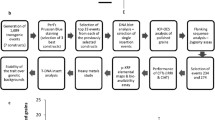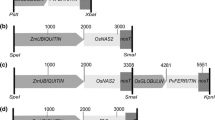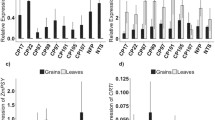Abstract
Low level of iron in staple food crops is one reason for the predominance of iron-deficiency anemia in developing countries. Most of the iron in rice grains accumulates in the outer aleurone layer and embryo, which are removed during milling, and the edible endosperm contains very low amounts of iron. In an effort to increase iron nutrition, we report here the transgene introgression of a high-iron trait into a high-yielding indica rice cultivar. The ferritin gene from soybean (soyfer1) was introduced into rice plants through interbreeding between soybean ferritin-overexpressing transgenic IR68144 and the high-yielding cultivar Swarna. The stable integration of the soyfer1 gene was confirmed in the BC2F4 generation, and the hybrid seeds showed 2.6-fold soybean ferritin gene expression over the recurrent parent Swarna. The hybrid milled seeds revealed a 2.54-fold increase in iron and 1.54-fold increase in zinc compared to Swarna. Agronomic data and an SSR marker analysis of the hybrid rice plants were taken into account for NIL character identification.




Similar content being viewed by others
Abbreviations
- IDA:
-
Iron-deficiency Anemia
- DW:
-
Dry Weight
- NIL:
-
Near-isogenic Line
- PCR:
-
Polymerase Chain Reaction
- PIC:
-
Polymorphism Information Content
- QTL:
-
Quantitative Trait Locus
- RIL:
-
Recombinant Inbred Lines
- SSR:
-
Simple Sequence Repeat
References
Lozoff B, Georgieff MK (2006) Iron deficiency and brain development. Semin Pediatr Neurol 13:158–165. doi:10.1016/j.spen.2006.08.004
Stein AJ, Meenakshi JV, Qaim M, Nestel P, Sachdev HP, Bhutta ZA (2008) Potential impacts of iron biofortification in India. Soc Sci Med 66:1797–1808. doi:10.1016/j.socscimed.2008.01.006
Gegios A, Amthor R, Maziya-Dixon B, Egesi C, Mallowa S, Nungo R, Gichuki S, Mbanaso A, Manary MJ (2010) Children consuming cassava as a staple food are at risk for inadequate zinc, iron and vitamin a intake. Plant Foods Hum Nutr 65:64–70. doi:10.1007/s11130-010-0157-5
Datta SK, Khush GS (2002) Improving rice to meet food and nutrient needs: biotechnological approaches. J Crop Prod 6:229–247. doi:10.1300/J144v06n01_12
Agte VV, Gokhale MK, Paknikar KM, Chiplonkar SA (1995) Assessment of pearl millet vs rice based diets for bioavailability of four trace metals. Plant Foods Hum Nutr 48:149–158. doi:10.1007/BF01088311
Pedersen B, Eggum BO (1983) The influence of milling on the nutritive value of flour from cereal grains. 4. Rice. Plant Foods Hum Nutr 33:267–278. doi:10.1007/BF01094756
Gregorio GB (2002) Progress in breeding for trace minerals in staple crops. J Nutr 132:500–502
Zhang M, Guo B, Peng ZM (2004) Genetic effects on Fe, Zn, Mn and P contents in indica black pericarp rice and their genetic correlations with grain characteristics. Euphytica 135:315–323. doi:10.1023/B:EUPH.0000013340.98344.60
Zeng Y, Zhang H, Wang L, Pu X, Du J, Yang S, Liu J (2010) Genotypic variation in element concentrations in brown rice from yunnan landraces in China. Enviro Geochem Hlth 32:165–177. doi:10.1007/s10653-009-9272-3
Paul S, Ali N, Sarkar SN, Datta SK, Datta K (2013) Loading and bioavailability of iron in cereal grains. Plant Cell Tiss Organ Cult 113:363–373. doi:10.1007/s11240-012-0286-7
Datta SK, Datta K, Parkhi V, Rai M, Baisakh N, Sahoo G, Rehana S, Bandyopadhayay A, Md A, Ali MS, Abrigo E, Oliva N, Torrizo L (2007) Golden rice: introgression, breeding and field evaluation. Euphytica 154:271–278. doi:10.1007/s10681-006-9311-4
Vasconcelos M, Datta K, Oliva N, Khalekuzzaman M, Torrizo L, Krishnan S, Oliveira M, Goto F, Datta SK (2003) Enhanced iron and zinc accumulation in transgenic rice with the ferritin gene. Plant Sci 164:371–378. doi:10.1016/S0168-9452(02)00421-1
Huang N, Angeles ER, Domingo J, Magpantay G, Singh S, Zhang G, Kumaravadivel N, Bennett J, Khush GS (1997) Pyramiding of bacterial blight resistance genes in rice: marker-assisted selection using RFLP and PCR. Theor Appl Genet 95:313–320. doi:10.1007/s001220050565
Meng L, Feldman L (2010) A rapid TRIzol- based two-step method for DNA-free RNA extraction from Arabidopsis siliques and dry seeds. Biotechnol J 5:183–186. doi:10.1002/biot.200900211
Jiang SL, Wu JG, Feng Y, Yang XE, Shi CH (2007) Correlation analysis of mineral element contents and quality traits in milled rice (Oryza sativa L.). J Agric Food Chem 55:9608–9613. doi:10.1021/jf071785w
Qu LQ, Yoshihara T, Ooyama A, Goto F, Takaiwa F (2005) Iron accumulation does not parallel the high expression level of ferritin in transgenic rice seeds. Planta 222:225–233. doi:10.1007/s00425-005-1530-8
Paul S, Ali N, Gayen D, Datta SK, Datta K (2012) Molecular breeding of Osfer2 gene to increase iron nutrition in rice. GM Crop Food 3:310–316. doi:10.4161/gmcr.22104
Akinwale RO, Badu-Aparaku B, Fakorede MAB, Vroh-Bi I (2014) Heterotic grouping of tropical early maturing-maize inbred lines based on combining ability in Striga-infested and Striga-free environments and the use of SSR markers for genotyping. Field Crop Res 156:48–62. doi:10.1016/j.fcr.2013.10.015
Acknowledgments
We extend our special thanks to the Department of Biotechnology (DBT) and University Grants Commission (UGC), Government of India for financial assistance. We express our sincere gratitude to Dr. Rajeev Varshney for his valuable guidance and kind cooperation in the PIC data analysis of the SSR marker studies.
Conflict of Interest
Each author of the article does not have any conflict of interest. The article does not contain any studies with human or animal subjects.
Author information
Authors and Affiliations
Corresponding author
Electronic supplementary material
Below is the link to the electronic supplementary material.
ESM 1
The figure showing the presence of soyfer1 gene in the progeny of FR 19-7 and iron and zinc contents of transgenic seeds of FR-19-7-6 (PDF 21 kb)
ESM 2
The figure showing iron and zinc content in seeds of local cultivars (PDF 29 kb)
ESM 3
The figure showing developmental pattern of BC2F4 generations (PDF 29 kb)
ESM 4
The figure showing dendrogram analysis of hybridized plants (PDF 16 kb)
ESM 5
Table represents the morphological characters of hybridized plants (PDF 22 kb)
ESM 6
Table represents the morphological characters of hybrid seeds (PDF 9 kb)
Rights and permissions
About this article
Cite this article
Paul, S., Ali, N., Datta, S.K. et al. Development of an Iron-enriched High-yieldings Indica Rice Cultivar by Introgression of A High-iron Trait from Transgenic Iron-biofortified Rice. Plant Foods Hum Nutr 69, 203–208 (2014). https://doi.org/10.1007/s11130-014-0431-z
Published:
Issue Date:
DOI: https://doi.org/10.1007/s11130-014-0431-z




